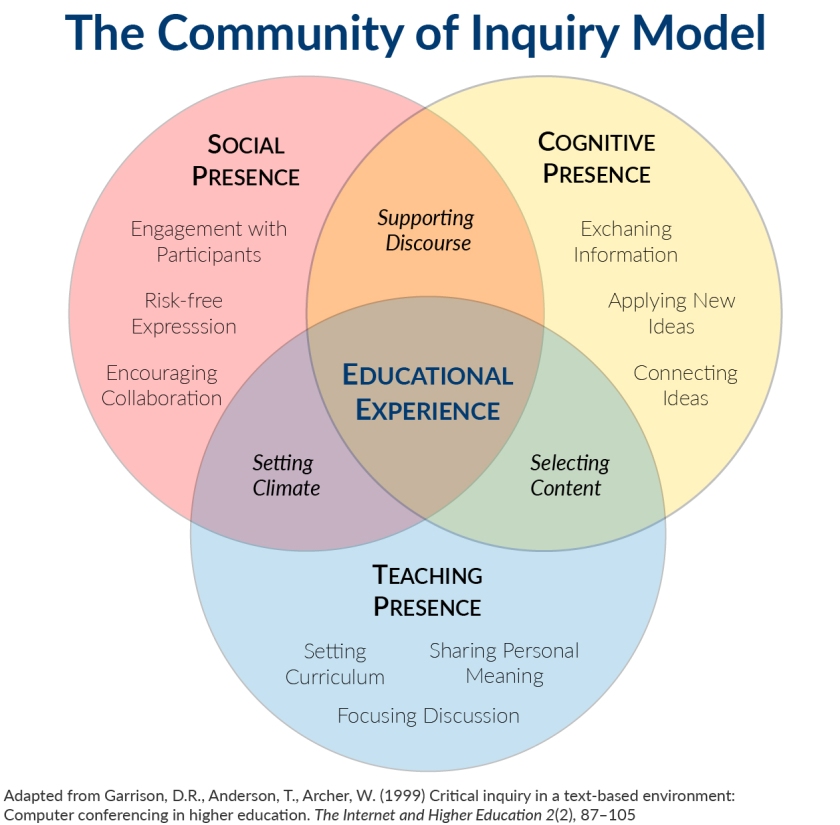As an online instructor, it can be challenging to create and maintain community with students in your courses. Last fall I discovered an education model that continues to help me create and maintain community, both as an instructional designer and as an adjunct instructor: Charles Sanders Peirce’s Community of Inquiry (CoI).
Throughout my next few blog posts, you’ll gain ideas for implementing the three presences of the CoI Model in your online classroom. So, what does it mean to have the CoI model as the theoretical foundation for your online classroom?
The Philosophy of Communities of Inquiry
Communities of Inquiry form when teachers and students are “dialogically inquisitive, active and reflective, articulate, cognitively adept, cooperative, sensitive to context, and explorative” (Pardales & Girod, 2006, p. 305). According to Charles Sanders Pierce, Communities of Inquiry produce knowledge that leads us from doubt to belief, and eventually helps us discover the ‘real.’ The ‘real’ evolves through the three presences of the CoI Model:
- social presence
- teaching presence
- cognitive presence
As I’ve explored and implemented the CoI Model, I’ve found that students are led to the ‘real’ when they realize what they believe about the subject they’re learning, become confident in sharing those beliefs, and in turn, become more open and willing to listen to and respect the beliefs of their peers.
Instructors begin to shape a Community of Inquiry by setting the tone at the outset of an online course. By demonstrating social, teaching, and cognitive presence, instructors lessen their students’ doubts, whether it’s their ability to comprehend the course material, or how they will get along with their instructor and peers.

Students begin to recognize and interact with the three presences through the community they build with their instructor and (independently of their instructor) with their peers. Students realize what they believe, become more willing to share their beliefs, and as a result, also become more respectful of and open to the beliefs of their peers. This creates a true Community of Inquiry.
Now, we’ll focus on using social presence to form a Community of Inquiry in your online classroom.
The Importance of Creating Social Presence Your Online Classroom
Social presence is the “degree to which learners feel socially and emotionally connected with others in an online environment” (Mouzouri, 2016, p. 41). Instructors should create social presence in an online classroom for two reasons:
- Students learn better in community.
- Students need to know their professor is available and wants them to succeed.
First, students learn better in community. Bill Pelz asserts, “Students don’t learn in isolation. They learn with and from other learners” (Banner, 2012). Similarly, Boettcher & Conrad note that, “communication and collaboration foster strong learning communities” (2010, p. 79).
Secondly, students need to know that their instructor is available (i.e., present in the course) and that he or she is invested in each student’s learning and success. Boettcher and Conrad assert, “Students often just need to hear an occasional ‘uh-huh’ to keep going and feel as if their efforts are being recognized” (2010, p. 77).
An instructor’s investment in a student and the community created through social presence significantly impacts a student’s motivation to learn. (Remember Keller’s ARCS Model of Motivation and Monroe’s Motivated Sequence?). When you’re actively present in an online course, students will know you care about their success and recognize their efforts to learn. This helps the students become better students.
Boettcher and Conrad further purport that providing a variety of communication channels “encourages student-to-teacher and student-to-student interaction, particularly if that communication is integrated well into assignments and begun early in the semester” (2010, p. 79). These communication channels include:
- Phone
- Video
- Discussion Forums
- Online Chats
Several studies reveal that learners’ “satisfaction with their online learning courses is directly related to the social or virtual presence of their faculty member” (Boettcher & Conrad, 2010, p. 75). It is also important to note that “regular and timely interaction of faculty with students is one of the key quality indicators of online courses.” (Boettcher & Conrad, 2010, p. 75).
Adding Social Presence into Your Online Course
You can begin adding social presence to your course by finding ways to help your students communicate and create community with each other. For example, this summer, I looked for ways to build the community in my classroom with my students as I redeveloped my online speech course.
As I considered the Community of Inquiry model, I decided to incorporate peer reviews as one of the new assignments. Each week, students will watch the speeches of two classmates. After the student views their classmates’ speeches, he or she will use an interactive rubric tool to give feedback to the other students.
Not only does this activity provide the students with additional feedback on their speeches, it also helps them learn how to give constructive feedback. Most importantly, this activity helps students form relationships and community along with their other assignments of this nature (like the Discussion Board).
When adding your own social presence to your course, you, as the instructor, can strive to build relationships and community with your students through:
- weekly announcement videos,
- additional announcements and reminders throughout the week,
- and providing thorough constructive feedback on assignments.
When I teach my speech course, I do my best to immediately respond to my students’ questions and concerns. In these ways, I not only lessen their doubts, but I also provide them ways to build relationships and community with me and with each other. This is a simple way to add social presence to your course without doing a full course redevelopment.
Further Exploration of the Community of Inquiry (CoI)
Whether it’s creating a new assignment or finding ways to create open and accessible lines of communication with your students, the possibilities of creating social presence in your online course are endless! In my next post, we’ll look at ways to implement teaching presence in your online courses.
Do you use the Community of Inquiry method in your online classroom? What’s your favorite part of the theory? Let us know in the comments or Twitter, and follow along as we explore adding teaching and cognitive presence to your courses in future weeks.

References
Boettcher, J. V., & Conrad, R.-M. (2010). The online teaching survival guide: Simple and practical pedagogical tips. Hoboken, NJ: Wiley.
Mouzouri, H. (2016). The relationships between students’ perceived learning styles and the community of inquiry presences in a graduate online course. International Journal Of Emerging Technologies In Learning, 11(4), 40-47. doi:10.3991/ijet.v11i04.5312
Pardales, M. J., & Girod, M. (2006). Community of Inquiry: Its past and present future. Educational Philosophy & Theory, 38(3), 299-309. doi:10.1111/j.1469-5812.2006.00196.x


Thank you for providing such a robust description of community of inquiry (COI). I have always found that following this method provides opportunities for online learners to enhance their learning process. Moreover, I have found that it is much easier to implement active learning activities once students gain insight into COI. They start to feel more comfortable in an online environment and are willing to take more risks. I think for me the best part of COI is the ability to bridge the communication gap within an online environment.
Ann
Different modes of learning have own advantages and disadvantages. Although online learning is widely becoming the norm in instruction provision to the wider population today worldwide Strayer University notes that there are several known disadvantages of online lessons including the following; Minimal in-person contact with professors and classmates, responses to questions are not always immediate and less social interaction outside of class. The Community of Inquiry (Col) Model is helping to reduce the effects of such challenges. The strategies outlined in the post are great.
Firstly, the idea of peer review places students on a better position as this will promote task oriented interaction.
Secondly, weekly video announcements can really make a difference due to the visibility of the instructor.
Additionally, the instructor may go further to create one-on-one interactions whose discussions may comprise an expansion of points raised by the learner in assignments and discussions posts. The instructor may also create informal interactions with the learners so that the learners really feel the presence of the instructor.
Lastly, on ‘thorough constructive feedback’, I feel that this is an already existing practice and is not really a game-changer but an expected norm
Douglas Namikungulu
Reference
Strayer University (n.d.) Challenges of Online Learning. Retrieved (July 16, 2018) from https://www.strayer.edu/